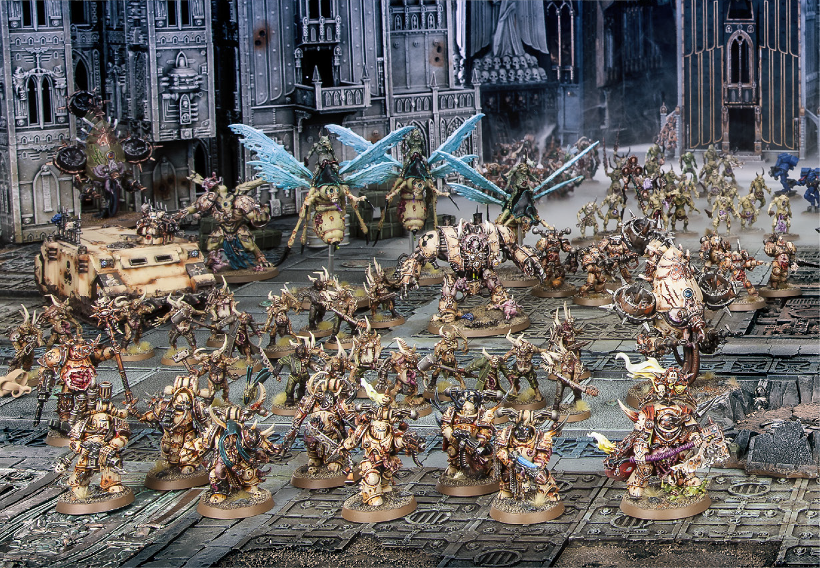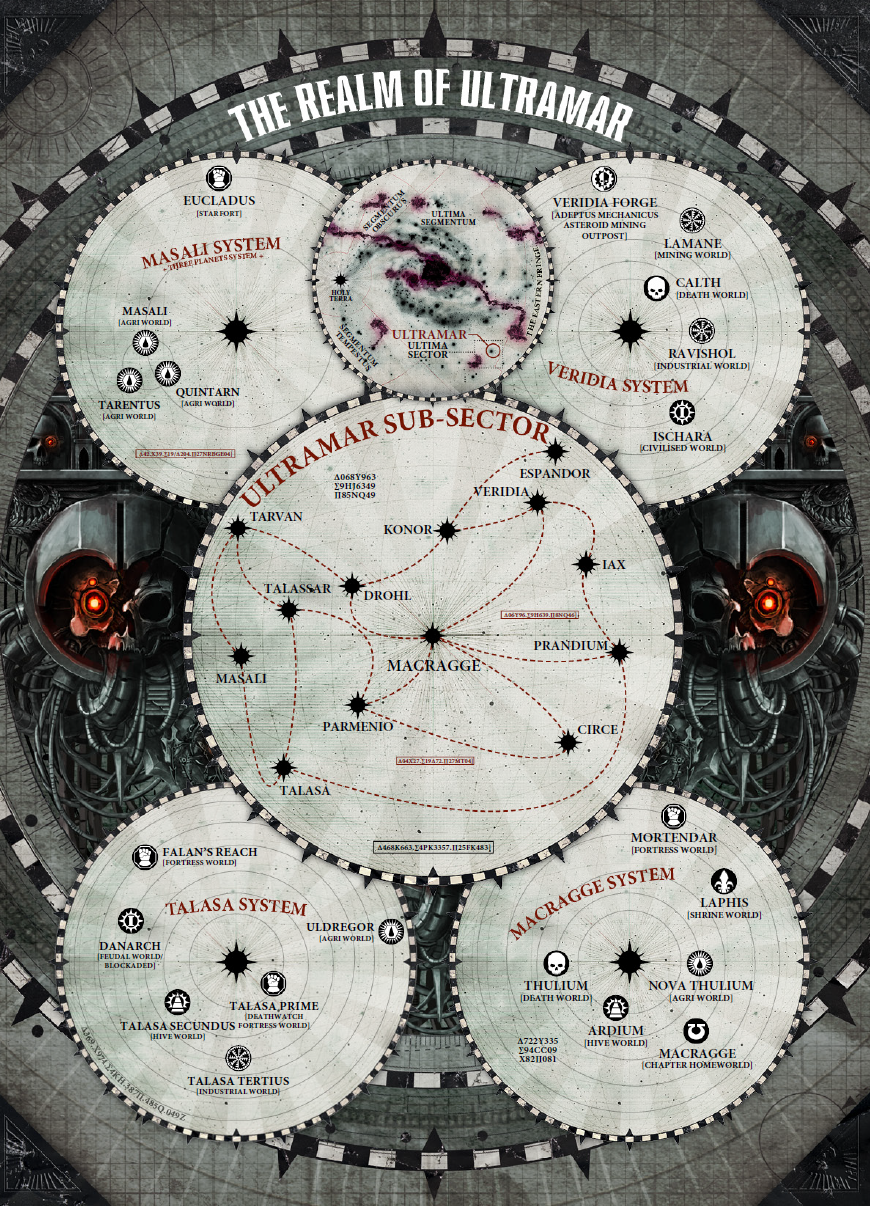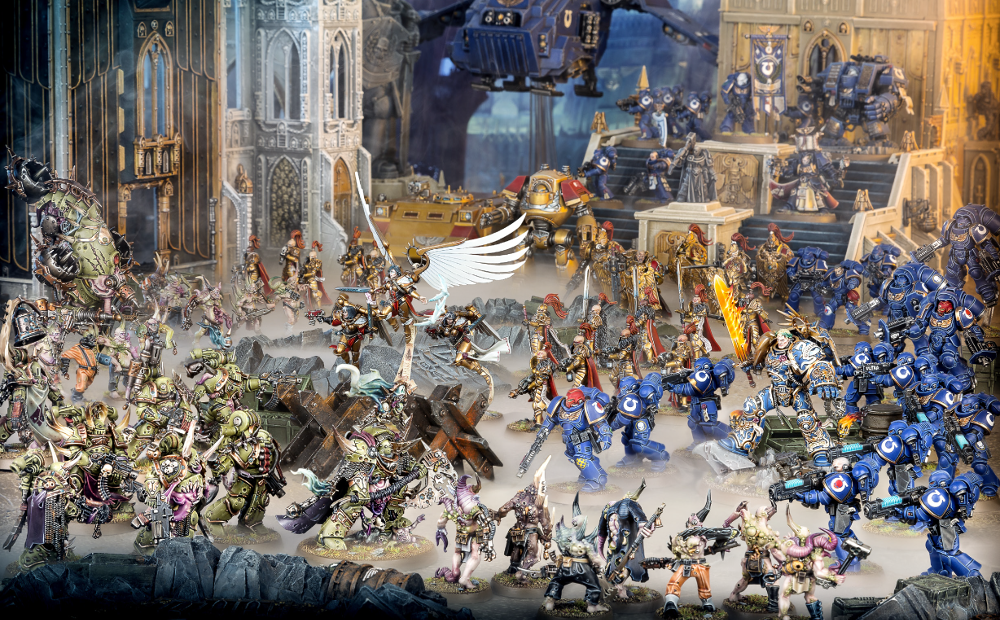
[ Models | Lore | Sources | Inspiration ]
In the Warhammer 40,000 setting, Poxwalkers are the afflicted victims of the Walking Pox, one of Nurgle's contagious diseases that animates the dead under the command of the Death Guard. They are a type of plague zombie. Various individuals have been known to spread the Walking Pox, including Typhus and Necrosius. The Poxwalker Hive may be used to further spread the virus.
Daemon insects spill from the tubular, chimney-like structures of the Poxwalker Hive. The incessant droning chatter of these tiny creatures acts as an infection in its own right, and those who willingly listen to it are at grave risk of contracting the poxwalker's curse. Should they succumb, they will devolve into shambling, mutant monstrosities, murmuring and babbling in the same flyblown tongue as the hive itself.
At the start of each of your turns, pick a friendly unit of Chaos Cultists within 7" to infect with the poxwalker virus. For the rest of the game, that unit of Chaos Cultists cannot Run or make shooting attacks, but they gain the Fearless and Feel No Pain special rules. In addition, at the start of each of your following turns, return D3 slain models to every friendly unit of infected Chaos Cultists that are within 7" of the bearer. Any models returned in this manner that cannot be placed within unit coherency are lost.

Something terrible came out of the warp storms as they roiled through the southern reaches of Ultima Segmentum. Where the seeds of corruption had been planted by the Plague That Walks, a new and terrible contamination spread. The diseased dead rose to claim the living. Previously, the walking corpses could be destroyed, but now doing so only released hordes of Nurglings that writhed impossibly out of the withered flesh of the fallen. Hive worlds were toppled, and as the Blackness descended, there was no escape. In the horrific ruins, Cults of Corruption slithered out of hiding, summoning forth further aid from the Realm of Chaos itself.
So did systems fall, creating the Scourge Stars - a trio of sickly systems that had fallen to Nurgle. From that power base, the Death Guard and Plague legions issued, systematically reaping planet after planet. On they spread. It was none other than the Daemon Primarch Mortarion that brought the fabled Realm of Ultramar, gem of the whole segmentum, under siege. Plague bombardments rained down, so severe that once gloried hives became pits and agri worlds became slime-ridden ruins. Chaos was encroaching on many fronts when Roboute Guilliman returned. It was his tactical acumen that first stabilised the many war fronts, and his Spear of Espandor counter-attacking campaign that successfully bought the forces of the Imperium still more time. At the Gates of Parmenio, Roboute Guilliman defeated the Greater Daemon Septicus and his Plague Guard. At Iax, once a glorious garden world, Primarch met Primarch as Guilliman confronted Mortarion, the two brothers fighting to a deadlock before the Chaos forces mysteriously withdrew under cover of a virus bomb.
Greedy eyes looked out from the roiling warp. They lingered long over the southern reaches of Ultima Segmentum. Nurgle wanted them for his own. He wished to lavish his gifts upon them, to watch their citizens sprout new growths and lament while other parts rotted and sloughed off.
The worlds of Ultramar were prosperous, well governed and aesthetically beautiful. It is no wonder that such a gem drew the eager eye of Nurgle. Wishing to annex those worlds directly into his own Garden in the Realm of Chaos, the Father of Plagues set his minions to the task. After the Great Rift tore reality and flooded warp energies into the galaxy, Nurgle deemed the time was ripe. Where seeds of corruption had been planted, where the Plague That Walks, the Oozing Pox, and the Eyerot had decimated overcrowded hive worlds, there did Nurgle put forth his greatest efforts. As darkness closed over those worlds, new, virulent strains of those dreadful diseases started the cycle of death anew. This time, however, the cycle was completed, for there was life also. From the corpses of the fallen burst countless Nurglings. In the devastation that ensued, Cults of Corruption summoned further aid. The following battles - known by the Imperium as the Plague Wars - ended when three systems to the galactic north of Ultramar were corrupted and turned into the Scourge Stars. Calling upon three of his greatest commanders, Nurgle tasked them with next conquering Ultramar.
The first invaders to issue forth from the Scourge Stars were the Death Guard, led by their grim Primarch, Mortarion. His meticulously planned seven-part campaign would bring untold ruination to all of Ultramar. So began the first part the War of Flies including the assault of the Three Planets, the besieging of the hive world of Ardium, and the Creeping Doom offensive against Espandor and Drohl. Virus bombardments preceded the Death Guard. Once-gloried hive cities became pits, and agri worlds became flyblown wastes. The attacks were slow but relentless, wearing down the Ultramarines and their auxilia. With communications severed and relief forces cut off by fresh warp storms, the defenders were hard-pressed in a hundred locations across Ultramar. Then, Roboute Guilliman returned from his galaxy-spanning crusade. Tactically, Mortarion and his fellow commanders now found themselves evenly matched, their offensives blocked at every turn by the Ultramarines and their Primarch's precise counter-attacks. A new stage of the war had begun.
In the early stages of the invasion of Ultramar, many different strikes were levelled at the capital world of Macragge. Whether Mortarion planned these events to probe the defences of the Ultramarines' home world, or merely aimed to tie down as many of the Imperial forces as he could, is unknown. All of the battles were short, sharp affairs, such as rapid strikes from Plague Drone forces, or cultist attacks attempting to deliver pox bombs into the heavily guarded defence networks. Whatever Mortarion's intent, the number and variety of the attacks steadily drained both morale and resources from Macragge until Primarch Guilliman returned and seized the initiative with his own strikes into Chaos-held territories.

In attacking Ultramar, Mortarion was not alone. Two other commanders led massive armies out from the Scourge Stars, each seeking to win the contaminated glory of Nurgle's favour.
Ku'gath Plaguefather, a favoured Great Unclean One, led the Bubonicus legions into Ultramar. Typhus, First Captain of the Death Guard, commanded a Plague Fleet, a dilapidated rot-armada packed with Renegades, cultists and his own loyal Death Guard. Ku'gath's Daemon legions ravaged the Tartella System, which lay between the Scourge Stars and Ultramar, before manifesting on the garden world of Iax, an ideal place to nurture new diseases. The Plague Fleet, meanwhile, destroyed three of the six massive star fortresses that stood sentinel over Ultramar's shipping lanes. Even with Guilliman's return, the attacks were too many and too widespread for the defenders to contain. The timely arrival of the Ultramarines' successor Chapters, however, along with reinforcements from several forge worlds, allowed the Primarch to attempt to regain the initiative. Guilliman launched the Spear of Espandor counter-attack, hoping to buy the forces of the Imperium more time.
Across Ultramar, the Plague Wars escalated. Guilliman's brilliant counter-attacks staved off defeat, allowing him to stabilise fronts across several systems. The largest battles of the war, however, were still to come.
With Mortarion's Creeping Doom offensive mired in continent-spanning trench warfare in the Espandor System, the Daemon Primarch shifted his focus, joining forces with Ku'gath. Together, they sent their surviving forces to Parmenio and Iax simultaneously. On Parmenio, the largest armour and Titan battle of the war took place over the shell-ridden Plains of Hecatone. At the battle's height, Roboute Guilliman struck against Ku'gath's vanguard, slaying his lieutenant, Septicus, and shattering his Plague Guard. In space, Galatan - Ultramar's largest star fortress - attempted to provide support but was boarded by the Plague Fleet. Massive casualties ensued, including the loss of the Novamarines' Chapter Master. The Ultramarines and their auxilia made gains on Parmenio, and Guilliman led a relief force to Iax. Once a verdant garden world, it was in ruins when Primarch met Primarch. Guilliman confronted Mortarion, fighting to a deadlock before the Death Guard withdrew under cover of a virus bomb.
The defence of Ultramar was really a tale of three parts: the initial losses, where the defenders gave ground before the Death Guard onslaught; the stabilisation with the return of Primarch Guilliman; and finally, the seizing of the initiative with the Primarch's counter-attacks along with the final battle.
*Many Chapters arrived to lend aid to Ultramar and to fight beneath Roboute Guilliman. The Primarch and Lord Commander of the Imperium organised those Adeptus Astartes in less-than-company numbers into battle-brother battalions, using them for special missions and to shore up the Ultramar Auxilia.
Let them flee beneath cover of their virus bomb. By the Emperor, they shall be repaid tenfold for the evils they have wrought upon Ultramar.
— Roboute Guilliman
The invasion of Ultramar began as separate spearheads, but as the campaigns slowed, Mortarion and Ku'gath formed an alliance. Unlike the Champions of the other Dark Gods, Nurgle's lieutenants were more capable of cooperation. This was not the case, however, between Typhus and Mortarion.
Bursting with life. Bursting with life. Bursting with life.
— War Drone of the Sloughskins

The mightiest heroes of the Imperium gather upon the steps of a sacred cathedrum, pitting their might against the suppurating traitors of the Death Guard in all their blighted glory.
Shambling across the battlefield in reeking hordes, Poxwalkers engulf their enemies in rotting tides of grasping hands, gnashing teeth and squirming tentacles. They are the cursed victims of Nurgle's plagues, transformed into unliving weapons by the cruel masters of the Death Guard.
Amongst the countless diseases propagated by the Death Guard, the zombie plague is amongst the most hideous. Its vector is the mighty Typhus, one of the Death Guard's greatest heroes and host to the daemonic Destroyer Hive. Wherever Typhus travels, this terrible plague spreads like wildfire, transmitted through bites and scratches then carried far and wide by fleeing victims and redeployed Imperial soldiery. Nurgle delights in variation, and so as the zombie plague travels it also mutates into countless strains. From the Plague of Despair to the Somnambuphage and the swift-spreading Spawnrot Fever, each has its own symptoms and effects. The Walking Pox is one such strain, afflicting those who battle the Death Guard directly.
Victims of the Walking Pox find their bodies rotting and shutting down until eventually, death takes them. Yet this is not the end. The victim remains cruelly conscious and aware, trapped within their corpse as it reanimates with a rictus grin and staggers out in search of living victims. Many Inquisitors of the Ordo Sepulturum hypothesise that the Walking Pox is a variant of Nurgle's Rot, for its victims' flesh mutates, even after death, sprouting horn-like growths from their skulls similar to those of Plaguebearers.
Whatever the case, Poxwalkers display rudimentary coordination, wielding battlefield debris as they stagger into battle. Though clumsy and slow, Poxwalkers are inhumanly resilient. Worse, the slightest exposure to the groaning cacophony that escapes their lips can afflict the souls of fresh victims, spreading the Walking Pox to anyone nearby as a spiritual contagion. In large numbers, these slouching corpse-mutants can prove incredibly dangerous, overrunning enemy lines, then gnawing, bludgeoning and ripping their screaming victims apart in bloody orgies of mindless violence.
Even if they are driven from the battlefield with barrages and firestorms of promethium, the profane gifts of Nurgle's children still linger. These include the disease known as Nurgle's Rot, a slow-acting but utterly fatal malady that agonisingly transforms the victim into a Plaguebearer, as well as the many strains of the dreaded zombie plague. The latter is a particular favourite amongst followers of the Lord of Decay, especially the hated Death Guard warbands. There are countless variations of this disease. Some are delivered by skyburst mortars into the upper atmosphere, while others are poured into a planet's water reserves or summoned in a pestilential monsoon by a pox-sorcerer's ritual. The most common strain deployed by the Death Guard keeps its victims alive and coherent even as it agonisingly reshapes their flesh. They become the shambling, rotting monsters known as Poxwalkers, whose role it is to soak up enemy fire before the advance of the Heretic Astartes, spreading their hideous infection amongst the foe even as las-fire and explosions blast them apart in gouts of pus and gore. The victim's mortal soul is trapped within this horrifying shell, unable to act or do anything but scream and beg for the blissful release of obliteration.